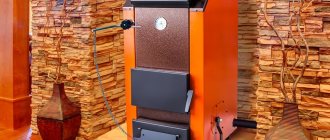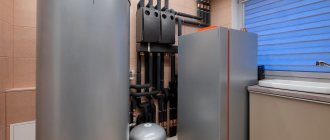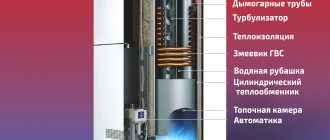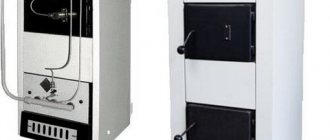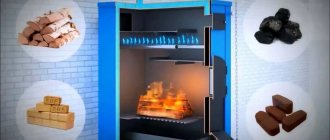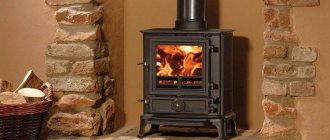Lemax Forward-12.5
- Power, kWt:
13 - Number of circuits:
1 - Type:
floor - Rating:
5.0
Advantages:
- energy dependence
- silent
- powerful
- price
- doesn't heat up outside
Flaws:
- inconvenient to clean
- vertical loading
- small firebox
- it is impossible to regulate smoldering
Solid fuel heating boilers are a worthy alternative to gas heat generators, especially when the house is not gasified. In particular, we are talking about coal models, since coal remains one of the most affordable types of fuel.
It should be noted that modern coal boilers for heating a private home both have functionality and characteristics that are generally much superior to classic stoves, which makes installing the former a truly profitable solution.
How to heat a house using a long-burning coal boiler
The device differs from a traditional oven in its long operation. The device uses the principle of top combustion. If the stove and standard solid fuel boilers take oxygen from below, through the provided grate, then such units have a special element. Through it, air enters the compartment from above. This helps make the combustion process completely controllable.
When air is supplied, the bulk of the coal is not affected, and combustion occurs almost layer by layer. Smoldering is observed - from the top of the raw material to the bottom, which helps ensure uniform heat transfer.
The boiler design includes the following components:
- Loading chamber, which occupies most of the internal space of the case.
- The entrance to the firebox, which is located at the top of the boiler.
- An air chamber that simultaneously performs the functions of a recuperator.
- A movable distributor, thanks to which oxygen is dispensed.
- Heat exchanger, also called a “water jacket”. It is built into the boiler body and runs along the entire perimeter of the combustion chamber. This heats up the coolant, which increases the temperature in the house.
- Telescopic air duct connecting the chamber to the distributor.
- Ash pan located at the bottom of the housing. It closes hermetically, unlike wood-fired boilers.
The chimney duct has a broken shape. Therefore, as gases pass through, energy is accumulated, and they are discharged through the pipe already cooled, while the heat remains in the house.
General information
A coal boiler is one that uses brown coal, hard coal, coal briquettes or anthracite to generate thermal energy and heat the coolant. Conversion of fuel into energy is carried out using the traditional method, using fuel combustion. When burned, the fuel generates thermal energy, which, in turn, heats the coolant - usually ordinary water. The hot coolant is sent further from the boiler - to the functional parts of the heating system: radiators, radiators, boiler, to heated floors, and so on.
The use of coal boilers is now very common, both for creating completely new heating systems and for modernizing existing ones. An important advantage that influences the high demand for this type of installation is the possibility of installing and connecting coal-fired boilers without any coordination or even design actions.
Types of coal boilers
Not all units are classified as long-burning equipment. There are efficient pyrolysis boilers, characterized by a high efficiency. They have 2 interconnected fireboxes. In chamber 1, coal smoldering occurs, and flammable gases are formed, which are then burned in compartment 2. This way the fuel is almost completely consumed. This not only improves the efficiency of the equipment, but also extends its operating time. 1 bookmark burns for 24-30 hours.
And if there is a special tank, then the process can take 7 days. Sometimes bunker boilers with automatic fuel supply are classified as a separate category.
Boiler with automatic feed
An automatic coal boiler is practical to use; the duration of the process is set on it, for a single placement of fuel, from 3 to 30 days, based on the fuel being loaded, the power and capacity of the container.
- These boilers operate on spilling fuel types: fine coal, pellets, wood chips and other elements.
- Please note that different fuels require different burner structures and fuel delivery mechanisms.
- For example, for pellets the burner corresponding to the name is very suitable, and for coal the best option would be a retort burner with special properties.
- When choosing a given boiler, it is important to determine what fuel will be used for it.
There are universal boilers specifically designed for pellets and fine coal. These boilers contain a container where the fuel is located and a mechanism for transferring this fuel to the combustion section.
Devices for transferring fuel raw materials are made of a mechanical type, operating with the help of augers, and pneumatic, operating on the basis of a compressor for pumping air.
Boilers with automatic transmission can come complete with built-in grates directly into the furnace for stacking coal with firewood. The combustion mode is controlled automatically.
These boilers are often equipped with many different unique functions: self-cleaning, control via telephone and other capabilities.
Advantages and disadvantages of equipment
A long-burning coal unit has the following advantages:
- saving resources, since the heating device consumes 20-30% less raw materials than other models;
- autonomy (most long-burning appliances on the market do not require an electrical connection);
- ease of maintenance (there is no need to clean the boiler often, and the procedure itself does not take much time);
- the ability to maintain a stable temperature;
- environmental cleanliness - the pulverized coal mixture practically does not accumulate in the room (as does smoke);
- reliability (due to its simple design, the boiler lasts a long time without breakdowns).
Such equipment also has disadvantages. For example, the impossibility of refueling, since you need to wait for the fuel to burn completely. In addition, the coal unit must be installed in a separate room. Equipment, especially with a bunker, takes up a lot of space, so the cost of installing a boiler room increases.
Users also note a higher cost compared to other types of heating devices.
Which coal is best and how to calculate consumption
Most long-burning boilers are not demanding on the quality of raw materials. But not all types are suitable for heating. For example, charcoal models are not found on the market. Anthracite is recommended only for specialized equipment. However, the quality of long-flame coal is close to it. This option is considered the best choice for autonomous heating at home.
It is better not to use brown coal for domestic boilers, unless specifically specified by the manufacturer. Brown has low efficiency, so its use is impractical.
The fraction of raw materials for automated systems is also important, since the latter are designed for fuel with a size of 5-25 mm.
Coal consumption is indicated by the manufacturer in the technical documentation. But you can make an average calculation yourself. If we assume that for heating an area of 10 sq. m requires 1 kW of thermal energy per hour, then per day with a building area of 100 sq. m requires 240 kW. When 1 kg of raw material is burned, an average of 7.75 kW is released. About 31 kg of fuel will be required in 24 hours.
However, it is necessary to take into account the calorific value of coal and its ash content. Also, the proportion must be adapted to the area of the house. For example, at 200 sq. m - 500 kW per day, since large heat losses are taken into account.
Tips for use
To ensure efficient operation of the boiler, you need to choose high-quality fuel. Most devices operate on hard coal, not all brands, which is reflected in the technical documentation.
In addition, it is required that the calorie and ash content of raw materials also meet the requirements. If the humidity level is higher than normal, which is 15-20%, then condensation will form in the pipe and excess moisture will begin to accumulate. Further operation of the unit will be accompanied by the appearance of an unpleasant odor, and the efficiency will begin to decrease (the same as when using high-ash coal).
Sometimes it is important to choose the right faction. For boilers with manual fuel supply, it is not particularly important. But in the documentation for devices with automatic loading of raw materials, there are clear requirements for it.
Firebox rules
The instructions state that:
- The fuel is loaded in such a way as to fill the entire volume of coal at once.
- For kindling, dry paper or wood chips are laid on top of the raw materials, which are set on fire automatically. The top door is open, but the air duct is closed.
- When the combustion process has begun, the door must be closed and the telescopic air duct regulator must be turned on.
The required temperature in such boilers is selected automatically. But in some models, adjustment is carried out using an air duct damper.
When the combustion cycle is completed, the remaining raw materials are removed from the loading chamber, the ash pan is cleaned and a new batch is poured.
Principle of operation
Increasing the duration of the combustion process is achieved not only by a large firebox. The organization of furnace combustion in the form of layered combustion with upper combustion and upper supply of blast air has a significant impact on efficiency and heat transfer, so gas-air flows do not circulate at all in the lower fuel layers.
Operating principle of a boiler unit with long-term combustion of solid fuel: The air required for fuel combustion is taken directly from the combustion chamber and passes through a preheating stage in the upper heating chamber of top-combustion boilers.
A pipe air distributor is built into the heating chamber to supply hot air to the combustion device. The feeding system can be gravitational or forced.
The air distributor is equipped with channels directed vertically. Before loading fuel, it is raised using a built-in mechanism, then fuel is poured in and the distributor, which rests on the upper fuel level, is lowered. As it burns out, it falls down the combustion space. This movement of the distributor provides air supply to the top layer of hot fuel.
In the contact zone of the air distributor with the fuel layer there is a steel disk - a staskoblin. Bypassing it, the fire enters the pyrolysis chamber located between the disk and the air heating chamber.
Here, flammable substances burn out completely, transferring heat through the walls of the firebox to the heating fluid circulating in the built-in heat exchanger. Flue gases are discharged through the gas outlet pipe into the chimney. The ash is collected in the ash box located at the bottom of the boiler unit, under the firebox. The volume of the box allows it to be cleaned at intervals of 2 to 5 loads.
Rating of the best coal boiler models
Good units are offered by foreign and domestic manufacturers.
The most popular devices are:
- Heiztechnik Q Alfa 15. This is a 15 kW boiler with a fairly high efficiency. Suitable for small houses with an area of 110 sq. m. The main advantages are versatility (works on coal, wood and briquettes), durable cast iron grates and a body made of boiler steel 5 mm thick. The device can last up to 20 years if used properly.
- Stropuva S15U. It is a boiler with a capacity of 15 kW. Powered by coal and pellets. A special feature of the equipment is the presence of a bimetallic draft regulator. This makes it possible to do without connecting to the mains.
- LIEPSNELE L20U. This is a unit of a Lithuanian brand. Power is 20 kW. The device operates on coal, wood, pellets, peat and wood shavings. When fully loaded, it maintains combustion for a week.
- Galmet “CARBO” 21. It is a Polish-made device with a power of 22 kW. Feature – high level of automation. The device has a pressure gauge, temperature sensor and flue gas sensor. This model also has a PID controller, which allows you to control the operation of the main components and control the combustion process.
- "WEEK KO-60." This is a Russian boiler with a capacity of 60 kW. The device is used for heating a private house with an area of up to 250 square meters. m. On 1 coal bed, the model works for 2-4 days. Modern equipment is equipped with a microprocessor unit that is insensitive to voltage surges and network failures.
Prices: summary table
Price rating of long-burning coal boilers (table):
| Long burning coal boiler model | Cost, rub. |
| Stropuva S15U | 85 400–90 560 |
| Heiztechnik Q Alfa 15 | 62 240–68 720 |
| Buderus Logano S181-15E | 218 000–250 640 |
| WEEK KO-60 | 115 900–130 500 |
| TIS (TIS) PRO 11 | 64 100–67 200 |
| LIEPSNELE L20U | 81 500–99 770 |
| VIADRUS Hercules U22D | 126 600 –128 530 |
| Galmet CARBO 21 | 103 890–116 750 |
Criterias of choice
The main aspect when purchasing is the boiler power. The principle of calculating the indicator is the same as for a wood-burning unit - per 10 square meters. m of area requires 1 kW of energy.
The material of the heat exchanger is taken into account. There are several options - stainless steel alloy, copper and cast iron products. The latter are more reliable, last longer, but cost more and increase the weight of the boiler. Copper is considered a durable and expensive option. Devices with steel elements are the cheapest.
Other selection criteria:
- Degree of workflow automation. There are models that provide for manual loading of fuel, and the rest (ignition, combustion maintenance) occurs without human intervention. But there are also fully automatic devices. Their design provides for the presence of a bunker through which fuel is periodically supplied to the boiler.
- Loading chamber volume. The size of the firebox directly depends on the power. The proportion is calculated as follows: per 1 kW of energy – 3.3-5.1 liters. For the most common version of a 25 kW boiler, a loading chamber of 110 liters is considered the norm.
- Possibility of using other types of fuel. There are models that operate not only on coal, but also on wood, sawdust, shavings, and pellets (a separate burner is installed for this).
- Functionality and type of control. Modern units are often equipped with thermostats, a self-cleaning system and weather-dependent automation. Safety switches and valves are responsible for safety. There are also boilers that are equipped with a GSM module.
Calculation of required heating power
Calculation of the thermal power of the boiler unit must cover all heat losses of the building with a margin of at least 20%. If the boiler must produce thermal energy to heat water, the power must accordingly increase in terms of the volume of water used in each specific case.
Calculating the heat loss of a building is quite complex; it depends on the climatic region of the facility’s location and the material of the walls and roof.
For an approximate calculation in the central region of Russia for houses with brickwork of at least 2 bricks and an interfloor height of 2.7 m, you can use the practical formula at the rate of 1 kW per 10 m2 of facility area with a margin of 20%.
For example, for a cottage with an area of 150 m2, the heating power of the boiler unit will be equal to:
150:10x1.2 = 18.0 kW
For a family of three, a domestic hot water tank of at least 100 liters with a power of 5.8 kW is required.
Thus, the total load on the boiler will be:
18.0 + 5.8 = 23.8 kW
Installation features and location selection
A coal boiler for heating a private house must be installed in a separate room. Moreover, the room should be quite spacious and with good ventilation. Non-combustible finishing materials must be used in the boiler room. Often it is necessary to make an additional concrete base for a heavy apparatus.
The installation of the unit is carried out by professionals. It is necessary not only to install the boiler, but also to connect it with heating and ventilation systems. At the same time, various auxiliary equipment is installed - a fan, valves, sensors, a water purification filter, an expansion tank. After installation, a test run is required.
Recently, combined units have become increasingly popular. An example is a gas-coal boiler, which is characterized by higher efficiency and autonomy.
You may be interested in information about what a DKVR boiler is and where it is used.
Reliable heating system for a country house
Maintaining a house in a habitable condition, provided that it is remote from the main communications, becomes a rather difficult task, associated with many difficulties and problems. If it is relatively simple to provide a house with electricity and water - it is enough to install a generator and arrange the supply of imported water - then with heat everything is somewhat different. Heating premises requires more significant labor, time and financial costs, but there are also solutions here. One of the most rational ways to heat the premises of a house is to install a solid fuel boiler, that is, a boiler that produces heat by burning solid fuel. The fuel here can be coal, wood and other energy sources that can provide enough heat to ensure a comfortable temperature throughout the entire house.
